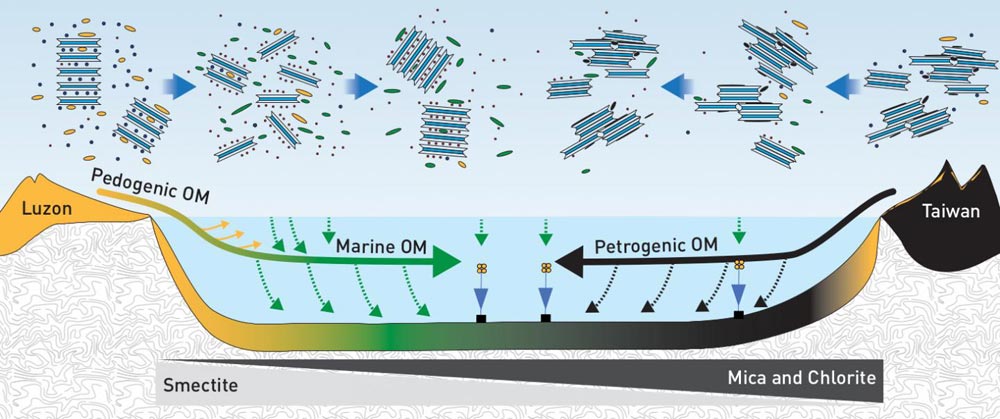

The path of clay minerals and organic matter bound to them from the land surface to marine sediment.
Graphic: ETH Zurich after Blattmann et al., Science 2019
Usage Restrictions: The rights to the images always remain with the person referred to as the copyright holder for them. Images published on ETH News may be used by other media and online portals only if ETH Zurich is specifically mentioned as the copyright holder and only in connection with the relevant ETH News article. Further distribution of images - for example, via download links - is permitted only with the approval of the editorial team.
On its way to the oceans, organic matter in sediments binds with clay minerals to form clay-?humus complexes. Once they reach the sea, these complexes sink to the seabed, where they are buried by other sediments.
This captures the carbon contained in these complexes, removing it over geological timescales from the atmosphere and from the pools of carbon standing in rapid exchange with Earth's surface.
This is why clay minerals, also known as phyllosilicates, are extremely important for the global carbon cycle: some 90 percent of the organic carbon sequestered in the seabed around the continents is related to reactions between organic material and various minerals.
A variety of phyllosilicates are responsible for a particularly large share because their small size and their geometry mean they have a particularly high specific surface area and can bind large quantities of carbon.
It all depends on the variety
However, not all clay minerals form stable complexes with organic substances. In a recent article in the journal Science, a team of researchers from ETH Zurich and Tongji University in Shanghai shows that different kinds of clay minerals interact with organic matter to varying degrees, in a process that determines the cycling of organic carbon.
This also affects the extent to which each clay mineral acts as an agent for carbon sequestration, since the binding of carbon with a particular phyllosilicates depends on its mineralogical structure and characteristics. The greater the specific surface area and the stronger its reactivity, the greater the quantity of organic matter that can bound to it and the higher the volume of carbon sequestered in the sediment.
The researchers studied these processes in the South China Sea, where the clay mineral smectite from Luzon (the main island of the Philippines), kaolinite from the Chinese mainland, and mica and chlorite from the mountains of Taiwan all meet. Thomas Blattmann, a former ETH doctoral student and the study's lead author, says that this sea offers the best conditions in the world for studying the interactions between phyllosilicates and organic matter.
Other oceans feature a “chaotic mixture” of phyllosilicates in which the processes that the researchers are interested in overlap. “That makes it harder to determine the effects of individual kinds of clay minerals. In contrast, in the South China Sea it's clear from which land mass each clay mineral is sourced – and that's unique.”
Clay minerals trap carbon
Smectite is formed when volcanic bedrock is chemically weathered; in freshwater, it binds with organic material from fertile, humus-?rich soils. Once these complexes reach saltwater, however, the smectites swap their organic loadings. They take up carbon compounds dissolved in the seawater and release the organic matter that originated from land to the ocean.
What happens to this organic matter next is unclear. Blattmann thinks it likely that organic substances from Luzon either oxidise, are consumed by microorganisms, or remain freely dissolved for thousands of years in seawater. Phyllosilicates from the mountains of Taiwan behave differently. They bind very tightly with continental carbon from Taiwan, carrying the organic matter quickly and efficiently into the sea.
“How carbon originating from land masses is transferred to the world's oceans and stored there ultimately depends on the kind of clay mineral. These minerals affect the large-?scale transfer of organic carbon from continents to their sink on the ocean floor,” Blattmann explains.
New findings raise new questions
“Phyllosilicates play a more important role in the global carbon cycle than we previously assumed,” says Tim Eglinton, a professor at the Geological Institute at ETH Zurich. The greater their specific surface area, the greater the quantity of organic matter they can take up and, consequently, the higher the volume of carbon they can sequester on the ocean floor. “However, this isn't something we can quantify, because we are only just beginning to understand the specific behaviour of these various clay minerals. It will take a great deal of additional research for us to arrive at any conclusions regarding the vast expanses of the world's oceans.”
###
Reference
Blattmann TM, Liu Z, Zhang Y, Zhao Y, Haghipour N, Montluçon DB, Plötze M, Eglinton TI. Mineralogical control on the fate of continentally-?derived organic matter in the ocean. Science 03 Oct 2019: eaax5345, DOI: 10.1126/science.aax5345














